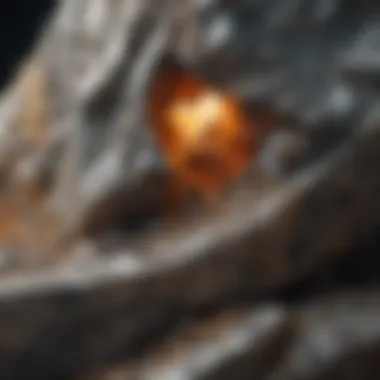Understanding Earth's Rocks and Minerals Guide


Intro
Understanding the composition of Earth's crust can be a fascinating journey. Rocks and minerals form the foundation of not only the planet but also of human civilization. They are essential for everything from the buildings we inhabit to the electronics we use. With this guide, we will delve deep into the various classifications of these natural elements.
History and Origins
The Earth’s rocks and minerals hold stories from millions of years ago.
Overview of Collectibles, Rocks, and Fossils
Collecting rocks and fossils is a pursuit enjoyed by many. Collectibles vary from simple stones to unique specimens that tell a story of the Earth’s past. Such collections can include igneous rocks formed from molten lava, sedimentary rocks formed from loose particles, and metamorphic rocks that have undergone transformation due to heat and pressure. Fossils, embedded within sedimentary layers, provide insight into ancient life forms and environments.
Historical Significance and Cultural Impact
Throughout history, rocks and minerals have had significant cultural impacts. Civilizations have used them for tools, jewelry, and decorative arts. For example, ancient Egyptians prized alabaster and lapis lazuli, incorporating these materials into their tombs and artifacts. This cultural relevance extends into modern society, where geology serves as a foundation for various scientific disciplines and industries.
"Rocks and minerals are not just geological tools; they are the storytellers of our planet’s history."
Identification and Classification
Identifying and classifying rocks and minerals can be intricate but rewarding. Different methods have been developed to assist collectors in this task.
Guide to Identifying Rocks and Fossils
Identifying rocks is often based on their physical characteristics, such as:
- Color: The color can hint at the mineral composition.
- Texture: Is it coarse or fine-grained?
- Hardness: How does it scratch against other materials?
- Luster: Does it shine like metal or is it dull?
Fossils, on the other hand, can be identified based on
- Shape: Different species leave distinct impressions.
- Location: Some fossils are found in specific geological formations.
- Size: Fossil sizes can indicate the type of organism.
Common Types and Variations
There are three primary classifications of rocks:
- Igneous Rocks: Formed from cooled magma and include examples like granite and basalt.
- Sedimentary Rocks: Created from sediment accumulation, comprising limestone and sandstone.
- Metamorphic Rocks: Resulting from transformed existing rocks, such as schist and marble.
Each type of rock carries distinctive properties, making them appealing across various fields, especially among rock and fossil collectors. This information is crucial in ensuring effective identification, which directly impacts both collecting and scientific understanding.
Prelims to Earth’s Geological Composition
Understanding Earth's geological composition serves as a foundational aspect of geology. This section offers insight into what constitutes the varied elements we find on Earth. The study of rocks and minerals reveals much about the planet's history, structure, and processes. It also has implications for various industries, ecology, and our daily lives. By grasping these concepts, rock and fossil collectors can appreciate not only what they gather but also the broader significance of these specimens.
Defining Rocks and Minerals
Rocks are naturally occurring solids composed of one or more minerals. They can vary widely in composition, texture, and origin. The definition of minerals, on the other hand, is more specific. A mineral is typically defined as a naturally occurring, inorganic solid with a definite chemical composition and crystalline structure. This distinction between the two is essential for understanding how they interact within the Earth's crust.
Rocks can be categorized into three primary types based on their formation processes:
- Igneous: Formed from the cooling and solidification of magma or lava.
- Sedimentary: Created by the accumulation and compaction of sediment, often in layers.
- Metamorphic: Resulting from the transformation of existing rocks due to heat and pressure.
Minerals, meanwhile, are categorized by their physical and chemical properties, which include hardness, luster, and color. For example, quartz is known for its hardness and clarity, while feldspar is recognized for its prominent presence in igneous rocks.
Importance of Rocks and Minerals
The importance of rocks and minerals cannot be overstated. They play crucial roles in various fields, from construction to the arts. The economic value of minerals is significant, impacting industries such as electronics, construction, and jewelry. Moreover, collecting rocks and minerals opens avenues for educational exploration and scientific research.
Rocks and minerals also tell stories about Earth’s geological history. Through analysis of rock layers and mineral content, scientists can decipher past environments and climate changes. This knowledge helps paint a clearer picture of how Earth has evolved over millennia.
In addition to practical applications, there is a cultural dimension to rocks and minerals. They have often been imbued with symbolic meanings in different cultures, and many people find personal significance in their collections.
"The study of rocks and minerals provides insight into both the Earth's history and its future, emphasizing their essential role in understanding our planet."
Classification of Rocks
Understanding the classification of rocks is essential for any study dealing with geology. This section highlights the different categories of rocks, specifically igneous, sedimentary, and metamorphic. Each of these classifications has unique characteristics and formation processes that contribute greatly to both Earth’s structure and the availability of various resources. By examining these types, readers can derive beneficial insights into their roles in natural processes and human use. This knowledge not only aids in increasing scientific literacy about geology but also equips rock and fossil collectors with critical information for their pursuits.
Igneous Rocks
Formation Process
Igneous rocks form from the cooling and solidification of magma or lava. This process can occur either beneath the Earth's surface, leading to intrusive igneous rocks, or on the surface through volcanic activity, resulting in extrusive igneous rocks. A key characteristic of the formation process is the temperature involved, as higher temperatures can lead to different minerals crystallizing from the molten rock. This process is a beneficial choice for understanding how new rocks are created and the characteristics they exhibit. The rapid cooling associated with extrusive igneous rocks, for example, often produces fine-grained textures, while slow cooling leads to coarser textures in intrusive rocks. The unique feature of this process lies in its ability to generate a wide range of textures and compositions. Its main disadvantage, however, is that volcanic activity can be unpredictable, causing hazards in populated regions.
Types of Igneous Rocks


Igneous rocks can be broadly categorized into two types: intrusive and extrusive. Intrusive igneous rocks, such as granite, crystallize slowly beneath the Earth’s surface. They often exhibit larger crystals and a coarse texture. Extrusive igneous rocks, on the other hand, form from lava cooling quickly after a volcanic eruption, leading to rocks like basalt, which typically have a fine-grained texture. The key characteristic of these types is their formation location, which significantly influences their properties. This classification is beneficial for understanding geological histories and processes of Earth's crust. A unique feature is that intrusive rocks usually contain a variety of minerals due to their prolonged cooling time. However, a disadvantage of categorizing them strictly is that some rocks may share characteristics of both types, complicating the classification.
Examples of Igneous Rocks
Common examples include granite and basalt, each serving as an illustration of the diversity within igneous rocks. Granite is known for its light color and coarse texture, making it popular in construction and ornamental stone. Conversely, basalt is often darker, with a fine texture, and is widely used as aggregate in concrete and road base. The key characteristic here is their mineral composition, which varies based on the conditions of their formation. Both are beneficial choices in their respective industries, emphasizing the practical aspects of these rock types. A unique feature is that granite can host valuable minerals like quartz and feldspar, adding economic significance. The disadvantage, however, is that sourcing good quality granite can sometimes be problematic due to geological constraints.
Sedimentary Rocks
Formation Process
Sedimentary rocks form through the accumulation and compaction of mineral and organic particles over time. The process is significant as it tends to occur in layers, often preserving fossils and geological history. A key characteristic of sedimentary rock formation is the gradual nature of the compaction, often taking thousands of years. This slow process allows for the formation of unique rock types like limestone and shale, making it a popular choice in geology due to its historical and practical significance. A unique element of this process is that it may involve chemical precipitation, leading to rocks that chemically originate from solutions, like rock salt. However, the disadvantage is that conditions must be suitable for long periods, limiting where sedimentary rocks can form.
Types of Sedimentary Rocks
Sedimentary rocks can be categorized into clastic, chemical, and organic types. Clastic sedimentary rocks are composed of fragments from other rocks, typically like sandstone. Chemical sedimentary rocks form from mineral precipitation, such as limestone, while organic sediments often include materials from living organisms, like coal. Each type represents a different sedimentary formation process, providing insights into the environment they originated from. This classification is beneficial as it helps geologists infer past conditions. A unique feature is that clastic rocks can vary dramatically in size and composition. One disadvantage is that sedimentary rocks can be prone to erosion, which makes their structures less stable compared to other rock types.
Examples of Sedimentary Rocks
Examples include sandstone, limestone, and shale. Sandstone is composed of sand particles and is known for its durability, widely used in construction. Limestone, primarily made of calcium carbonate, is essential in producing cement. Shale, on the other hand, is fine-grained and may contain organic material, often leading to oil and gas reservoirs. Their key characteristics make these rocks crucial for various industries and environmental studies. The economic benefit of limestone, in particular, is noteworthy as it forms a base for many construction materials. Unique features of these rocks often include their layered appearance, which can vividly display the historical accumulation of materials. A disadvantage for collectors is that many sedimentary rocks can be brittle and may break easily, complicating their collection and preservation.
Metamorphic Rocks
Formation Process
Metamorphic rocks emerge from pre-existing rocks subjected to high heat and pressure over time. This process is vital for understanding how rocks can transform and adapt under extreme conditions. A unique characteristic of metamorphic formation is the alteration of minerals within the rock, leading to different textures or new mineral assemblages. The metamorphism can be regional, affecting a wide area, or contact-based, occurring near molten rock. The benefits of studying this process include grasping the Earth’s dynamic nature and the cycles that affect rock formation. However, one disadvantage is that the resulting rocks can be challenging to identify, as the original rock’s characteristics may be largely obscured.
Types of Metamorphic Rocks
There are two primary types of metamorphic rocks: foliated and non-foliated. Foliated metamorphic rocks develop layers or banding due to the alignment of minerals, as seen in schist and gneiss. Non-foliated metamorphic rocks do not exhibit such banding and include rocks like marble and quartzite. This classification helps in understanding the conditions under which these rocks formed and their geological significance. A key characteristic is that foliated rocks tend to have a distinct layered appearance, indicating directional pressure. A unique feature is how non-foliated rocks retain the composition of their parent rocks, making classification based on texture important. The disadvantage of this classification is that it might confuse collectors who encounter rocks with ambiguous characteristics.
Examples of Metamorphic Rocks
Famous examples include marble and schist, both widely term are often used in art and architecture. Marble is prized for its beauty and is commonly used for sculptures and buildings. Schist is known for its shiny, layered appearance, often containing mica, which enhances its aesthetic value. The key characteristic of these rocks is their altered mineral composition that gives them distinct appearances. This makes them attractive choices for collectors and builders. A unique feature of metamorphic rocks is how they reflect the conditions they were formed under, providing a snapshot of geological history. One disadvantage is that some metamorphic rocks can be costly and difficult to source, often requiring specialized knowledge to collect and preserve them.
In-Depth Look at Minerals
Understanding minerals is essential in the study of geology and Earth’s composition. Minerals serve as the building blocks of rocks and play a vital role in numerous geological processes. This section will provide a closer examination of how minerals are identified and classified, as well as their practical applications in various industries.
Mineral Identification and Classification
Physical Properties
The physical properties of minerals are fundamental for their identification. Color, luster, hardness, and streak are key characteristics that help distinguish them from one another. For example, quartz is well-known for its hardness, making it highly resistant to scratching. This aspect is beneficial for collectors and enthusiasts because it provides guidance for recognizing minerals in the field.
In terms of disadvantages, some minerals can change color due to impurities or weathering, complicating identification.
Chemical Composition
Chemical composition is another crucial factor in mineral identification. Each mineral has a specific chemical formula reflecting its elemental composition and structure. For example, calcite is defined by its chemical formula, CaCO3, which helps to identify it among other minerals. The clear and precise nature of chemical composition provides a solid basis for categorization, aiding researchers and collectors in their studies. However, determining chemical composition often requires specialized equipment, such as X-ray fluorescence, which can limit accessibility for casual collectors.
Crystal Structure
The crystal structure of a mineral reveals its internal arrangement of atoms. This arrangement dictates the mineral's physical characteristics and behavior. The uniqueness of a crystal structure provides distinct shapes and habits that assist in identification. For instance, the cubic structure of halite is easily recognizable and distinguishes it from other mineral classes. While the optical properties related to crystal structures can be technically complex and not always easy to observe, they play a significant role in the academic study of minerals.
Common Minerals and Their Uses
Quartz
Quartz is one of the most abundant minerals on Earth. It is primarily composed of silicon dioxide. Its durability and resistance to weathering make it an important mineral for both industrial applications and in the natural environment. Quartz is widely used in electronics, glass production, and even in watches due to its piezoelectric properties. The appeal of quartz lies in its availability and versatility, making it a popular choice among collectors.
However, its abundance means that less rare varieties might not hold the same value in collections.
Feldspar
Feldspar is a group of minerals that are essential in the formation of igneous and metamorphic rocks. Representing about 60% of the Earth's crust, they are vital for assessing geological history. Feldspar is commonly used in ceramics and glassmaking due to its ability to withstand high temperatures. This highlights its industrial importance and widespread applications. The main disadvantage is that feldspar may not be as visually striking as other minerals, potentially making it less appealing to collectors.
Calcite
Calcite is a carbonate mineral known for its effervescence in dilute hydrochloric acid. This distinctive property helps in its identification and is useful in various industrial processes. Calcite is used in cement and plaster production, making it crucial for construction. Its widespread availability adds to its economic value but can dilute its desirability among mineral collectors due to the abundance of similar specimens.
Minerals tell a story about Earth’s history, each one a testament to the processes that shaped our planet.
By understanding these minerals and their properties, both geological enthusiasts and professionals can gain valuable insights into Earth's processes and resource utilization.
Geological Processes and Rock Cycle


Understanding geological processes is crucial to comprehending Earth's rocks and minerals. These processes outline how rocks transform and recycle over time, which is fundamental to our planet's geology. The rock cycle is an ongoing system that connects igneous, sedimentary, and metamorphic rocks through various steps, showing the dynamic nature of the Earth. In this section, we will look closely at the individual processes involved in the rock cycle.
The Rock Cycle Explained
Weathering and Erosion
Weathering and erosion are important processes in the rock cycle. Weathering breaks down rocks into smaller pieces due to environmental factors such as temperature changes, water, and chemicals. Erosion is the movement of those smaller particles by agents like wind, water, or ice. Together, these processes contribute significantly to landscape changes and soil formation.
Key characteristic: Weathering and erosion continuously reshape the Earth's surface, providing an essential service. They create sediment that can lead to new rock formation.
Unique feature: These processes can take a long time, sometimes millions of years, yet they are impactful in shaping the geographical features we see today. The slow nature can also be a disadvantage when looking at rapid geographical changes or human impact on landscapes.
Transportation and Deposition
Transportation refers to the movement of eroded materials from one location to another. This often occurs via rivers, glaciers, or wind. Once these materials lose their energy, they settle down. This settling is known as deposition.
Key characteristic: The ability of various agents of transportation allows for a diverse range of sediments to gather in different locations, helping to form sedimentary rocks.
Unique feature: While transportation is crucial for sediment movement, deposition leads to rock layering, which becomes informative for geologists in understanding the Earth's history. However, the potential loss of sediments during transportation can limit the size of deposits formed.
Metamorphism
Metamorphism is the process that changes existing rocks into metamorphic rocks under heat and pressure. It occurs deep within the Earth, impacting the size, shape, and mineral composition of the rocks involved. This transformation is vital because it helps create a new category of rocks.
Key characteristic: Metamorphism can occur over a wide range of temperatures and pressures, leading to different types of metamorphic rocks.
Unique feature: This process is significant for collectors because many beautiful gemstones and minerals are a result of metamorphic processes. Yet, identifying these rocks can be challenging due to their altered characteristics, complicating the collecting process.
Plate Tectonics and Rock Formation
Plate tectonics plays a crucial role in rock formation. This theory explains how Earth's lithosphere is divided into tectonic plates that move over time. Interactions between these plates lead to various geological phenomena, including the creation of mountains, earthquakes, and volcanic activity. The movement of these plates also cycles materials back into the mantle, continuing the rock cycle.
Continental Drift
Continental drift is a specific theory that describes the movement of the Earth's continents over geological time. This shifting impacts rock formation as landmasses collide or separate, leading to various geological features including mountain ranges and rift valleys.
Key characteristic: This long-term movement causes significant geological changes and influences the type of rocks and minerals found in different areas.
Unique feature: The evidence of continental drift supports the understanding of past environmental conditions and assists in predicting future changes. However, this prospect requires long-term study to fully grasp its implications on geology.
Subduction Zones
Subduction zones occur where one tectonic plate is forced beneath another. This process not only leads to the creation of volcanic activity but also gives rise to significant rock formations. The pressure and heat at these zones cause rocks to melt and form magma.
Key characteristic: Subduction zones are critical areas where recycling of crustal materials occurs, leading to new rock formations.
Unique feature: The resultant magma can lead to the formation of igneous rocks, thereby continuing the rock cycle. The potential for tectonic activity, however, raises concerns about geological hazards such as earthquakes and tsunamis.
Magma Formation
Magma formation is a key aspect of how new igneous rocks are created. This molten rock originates from the melting of rocks in the crust and upper mantle. When magma rises to the Earth's surface, it can erupt as lava, ultimately solidifying into igneous rocks.
Key characteristic: Magma formation converts existing materials into new materials, a fundamental process in the rock cycle.
Unique feature: The type of magma formed can significantly influence the nature of the igneous rocks created, which is important knowledge for collectors looking to understand the origins of specific mineral specimens. However, volcanic eruptions can also present risks, impacting local ecosystems and communities.
Societal Implications of Rocks and Minerals
The study of rocks and minerals transcends mere geological interest. Their implications for society are substantial. Economic progress, cultural identity, and historical context intertwine through these natural resources. When humans engage with rocks and minerals, they do more than collect; they partake in a relationship that shapes economies, cultures, and industries.
Economic Value of Minerals
Mining Industry
The mining industry is a backbone of many economies worldwide. It extracts essential minerals for various applications, from construction to electronics. Mining creates jobs and fosters local economies. The industry contributes significantly to exports, which can improve a country's balance of payments. However, environmental concerns must be addressed. Mining can lead to degradation of ecosystems if not managed properly.
Material Applications
Materials derived from rocks and minerals are integral to modern society. Whether in construction, technology, or healthcare, minerals form the foundation of countless products. Metals like copper and iron are vital for infrastructure. Quartz is used in electronics as it enables precise timekeeping. The versatility of these materials highlights their importance in daily life. However, reliance on finite resources may present future challenges in sustainability.
Value in Trade
The trade of minerals represents a crucial aspect of global economics. Countries rich in certain minerals can trade them for resources they lack. Rare earth elements, for example, are indispensable for high-tech industries. Their rarity increases their value on the international market. Conversely, dependency on imported minerals can create vulnerabilities in a nation's economy, affecting its stability.
Cultural Significance of Rocks


Rocks in Art
Rocks serve as a canvas in art. Artists utilize stones and minerals to create sculptures and installations, bringing natural beauty into galleries and public spaces. The unique textures and colors offer endless inspiration. From ancient carvings to contemporary pieces, the use of rocks in art reflects cultural identity and history. However, sourcing these materials ethically is essential to prevent exploitation.
Historical Use of Minerals
Throughout history, humans have utilized minerals for various purposes. Stones like flint have been used in tool-making since prehistoric times. Copper and gold became symbols of wealth and power in ancient civilizations. The historical context of minerals reveals much about societal development and technological advancement. Understanding this history can also highlight the role minerals have in shaping human advancement.
Symbolism in Different Cultures
Minerals carry profound meanings in various cultures. For instance, jade is esteemed in Chinese culture, symbolizing purity and moral integrity. In many indigenous cultures, certain stones hold spiritual significance, often used in rituals. This use and symbolism can create a deeper connection to the earth among communities. However, it is vital to approach these meanings with respect to cultural sensitivity and acknowledgment of historical inequalities.
Collecting Rocks and Minerals
Collecting rocks and minerals is not only an engaging hobby; it also serves as a significant avenue for educational exploration. Understanding the various characteristics of different materials fosters a deeper appreciation of geological processes. Collections can provide insight into the Earth's history, highlighting local geology and broader geological phenomena. Enthusiasts often find connections to related fields like environmental science or archaeology, expanding their knowledge and network.
Moreover, well-curated collections can become valuable over time. Possessing rare specimens may offer both personal joy and economic benefit.
How to Start a Collection
Choosing Your Focus
Choosing your focus is an essential first step in rock and mineral collecting. It involves deciding on specific categories, such as local minerals, gemstones, or fossils. A clear focus helps streamline your efforts and research. For instance, if you opt for local rocks, you can strengthen your knowledge of your area's geological background.
A popular choice is gemstones, which attract collectors for their beauty and craftsmanship in jewelry. This specific focus allows enthusiasts to appreciate not only the aesthetic qualities but also the geological processes involved in their formation. Additionally, focusing on a specific type of collection can be less overwhelming for beginners, making it a beneficial choice for getting started. The downside may be limiting exposure to the diversity within the world of rocks and minerals.
Tools and Resources Needed
Tools and resources are crucial for successful collecting. Basic tools include a rock hammer for breaking rocks, a field guide for identification, and safety gear like gloves and goggles. These items can significantly enhance your experience in the field.
A notable key characteristic of these tools is their accessibility. Many basic tools are relatively inexpensive and widely available in scientific or outdoor stores, making it a popular choice among beginners. Online resources, such as websites and forums, can provide guidance and additional materials for research. A possible disadvantage, however, may arise from the indecisiveness on what is essential, especially when starting out, leading to over-purchasing or unnecessary items.
Field Collecting Tips
Field collecting tips offer practical guidance for enthusiasts embarking on their rock and mineral journey. Understanding your local geology beforehand can make a significant difference. Maps and geological surveys can be helpful in locating productive sites.
One effective tip is to collect near weathered rock face, where various minerals are more accessible due to erosion. It is a popular approach because it maximizes the chances of finding diverse specimens. However, one should always respect local laws and regulations regarding collecting. Pay attention to ethical considerations, such as not disturbing wildlife or damaging natural landscapes, as it enhances the sustainability of collecting practices.
Caring for Your Collection
Caring for your collection ensures the longevity and aesthetic appeal of your specimens. Proper care increases both the value and enjoyment of your collection, aligning with best practices in preservation. It includes cleaning, displaying, and documenting your rocks and minerals to maintain their condition.
Cleaning and Preservation Techniques
Cleaning and preservation techniques are vital for maintaining the integrity of minerals and rocks over time. It includes methods like gentle washing with distilled water, avoiding harsh chemicals, and using brushes for intricate pieces. These techniques help eliminate dirt and grime without causing damage, keeping your specimens looking attractive.
A key characteristic is the emphasis on gentle handling. This approach can be beneficial for maintaining the specimen's original features and characteristics. However, meticulousness is essential; too much scrubbing or inappropriate tools can result in irreversible harm,
Display Options
Display options for collected rocks and minerals allow collectors to showcase their specimens while protecting them. Using glass cases or dedicated shelves provides visibility and protection from environmental factors.
A popular choice among collectors is arranging specimens by type or location, which enhances aesthetic appeal and organization. Creative display options also foster better engagement during discussions. The disadvantage may be the space required for larger collections, affecting how much can be displayed at once.
Record Keeping and Documentation
Record keeping and documentation are crucial for serious collectors. This involves noting when and where specimens were collected, along with any relevant characteristics. A well-maintained logbook adds considerable value to a collection, offering insights into growth and development through the years.
The key feature is the ability to track your progress as a collector. This practice can assist in identifying trends or noticing gaps in your collection. While digital tools offer modern conveniences, handwritten records can serve as a personal touch. However, the potential for loss or damage to documentation is a challenge that requires diligent management.
Finale and Future Directions
The conclusion serves as a vital synthesis of the information presented in this article. Understanding the complexities of Earth's rocks and minerals greatly enhances our knowledge of geosciences. It is important to recognize the interconnectedness of the various rock types and the minerals they encompass. Each category, whether igneous, sedimentary, or metamorphic, plays a unique role in Earth's geological story. This intricate interplay also extends into considerations of economic viability, educational pursuits, and personal collecting interests.
As we closed them discussion on rocks and minerals, the implications for human activities become clear. The utility of these materials in diverse industry sectors, including construction, technology, and art, underscores their beneficial attributes beyond mere aesthetics. For collectors, a profound understanding of these natural elements fosters a deeper appreciation and knowledgeable approach towards acquisition, conservation, and display.
"The rocks beneath our feet tell a story of the Earth's history and evolution, a narrative we can learn from and appreciate."
Recap of Key Takeaways
The key points discussed throughout this article can be summarized as follows:
- Rocks and Minerals Defined: They form the foundational elements of the Earth's crust, each with distinct characteristics and significance.
- Classification Importance: Understanding the classification of rocks into igneous, sedimentary, and metamorphic reveals much about geological processes and the environments in which they form.
- Minerals and Their Uses: Knowledge of common minerals such as quartz and feldspar illuminates their practical applications in everyday life and industry.
- Geological Processes: The rock cycle and plate tectonics illustrate the dynamic nature of Earth's surface and its composition.
- Cultural and Societal Implications: The aesthetic and symbolic roles of rocks and minerals in various cultures highlight the significance beyond scientific importance.
Emerging Trends in Geology and Collecting
The field of geology is continually evolving. Emerging trends can lead to new understanding and techniques in the study and preservation of rocks and minerals.
- Technological Advances: Innovations in analysis tools allow for more detailed mineral identification and testing, providing greater insights into material properties and potential uses.
- Sustainability: There is a growing emphasis on sustainable mining practices, as society becomes more aware of the long-term impacts of extraction on the environment. The importance of responsibly sourced materials is crucial in both industrial and collector practices.
- Citizen Science: More enthusiasts are engaging in geological fieldwork, collecting and documenting finds, which contributes to broader geoscientific research.
- Educational Outreach: Understanding geology is increasingly incorporated into educational curriculums, emphasizing the relevance of rocks and minerals in everyday life and future industries.
By examining these trends, collectors and scholars can anticipate developments and adapt to new challenges and opportunities in their pursuits. Engaging with these aspects not only enhances individual collections but also fosters a greater appreciation for the geological legacy we inherit.



